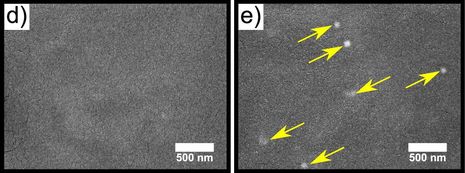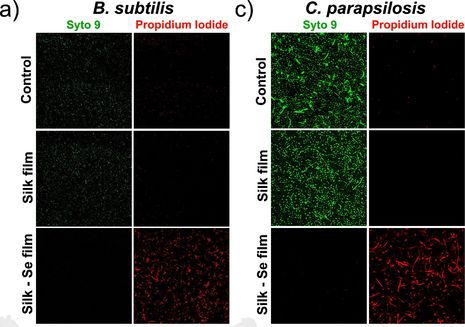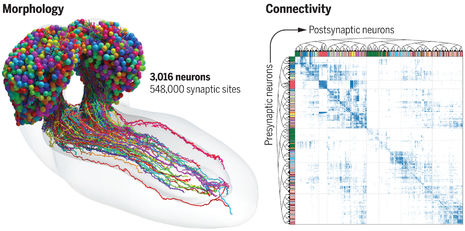Research Round-up: Week 8
From silk-selenium film to smartphones and trees, from diagnostic confidence to cutting edge neuroscience, here’s some of the research coming out of Cambridge

Cambridge pioneers new antimicrobial biomaterial
Researchers from the Yusuf Hamied Department of Chemistry here in Cambridge have trialled a new material to combat the problem of drug resistance in bacteria and fungi
The new method provides an "orthogonal" way to tackle drug resistance - providing an entirely novel treatment for patients infected with pathogenic strains resistant to current therapeutic methods.
The group made use of regenerated silk fibroin, which can be derived from silk made by the Bombyx mori silkworm. The material is relatively common to this kind of research; it is durable and biocompatible, and perhaps most importantly can be 'tuned' into specific three-dimensional structures by exploiting its biological properties.
The researchers embedded selenium nanoparticles into a silk-based film; the addition of the selenium allowed the material to exhibit both antibacterial and antifungal properties - but crucially remaining non-harmful to our own cells due to its silk fibroin substrate.

The research could find its way into therapeutic applications like topical wound dressings. The team intend to research how their biomaterial could be integrated into existing manufacturing technology - this could potentially permit on-demand production of antimicrobial devices with bespoke geometries, which could be highly relevant for use in hospitals.
The effect of skin colour on diagnostic confidence
A collaboration between researchers from Cambridge and five other institutions has examined the role skin colour plays in diagnostic outcomes, and in the diagnostic confidence of trainee medical students, in their 5th year of study.
The research presented the students with 24 images representing 12 different skin conditions, including shingles, eczema and chicken pox. Each condition had two associated images, one of a patient with non-white skin (NWS), and one with white skin (WS).
The study found that the students were more accurate in diagnosing five of the conditions on white skin than on non-white skin, compared to one condition (jaundice) where participants were more accurate in the opposite direction.
Qualitatively, the students were more confident in eight of 12 conditions on WS than NWS, and more confident for two of the conditions the other way. Fielding comments from participants, the need for medical textbooks and other resources to include a diversity of skin colours was highlighted, as well as the impact of COVID on dermatology placements. One participant mentioned that they believed their lack of confidence would be improved with more studying.
Using mobiles to study forest health
A study out of Cambridge and Canada's University of Waterloo has developed a new way to monitor the health and devlopment of forests.

The planting of trees is one way in which climate change can be tackled. However, simply planting trees is not enough; in order to be an effective carbon sink, the trees need to be monitored closely; forest fires, poor tree health and other dangers present problems to stable sequestration, making forest monitoring vital.
Monitoring efforts are typically cumbersome and time-consuming, requiring manual measurements of the circumferences of individual trees, or otherwise requiring costly and bulky laser-sensing equipment, but the new study has potentially solved this problem:
Building an app for a Huawei P30 Pro smartphone, the researchers were able to accurately estimate the trunk diameter of trees based on one picture alone, making use of the phone's built-in LiDAR sensor to do so.
The tech had a mean absolute error of only 8% - being out by mere centimetres on average. It performed well in a variety of seasons and different forests, and reduced the total surveying time by almost a factor of five, compared to manual measurements of the same trees.

ALternative phone-based systems have been tested favourably in the past, but these have often required the capturing of multiple pictures for each tree, at many different angles - making it difficult to deploy in forests with dense foliage or obstacles like branches.
The research has obvious implications for facilitating broader and more extensive surveying of forests, though the researchers point out more work is needed to verify their model - the majority of their dataset consisted of trees with diameters less than half a metre.
Mapping the brain
Scientists have successfully added one more brain they can claim to have successfully mapped, bringing the total to four.
A complete brain map, called a 'connectome' describes the total structure of a brain, down to a resolution of individual synapses - the gaps between neurons. By successfully producing a connectome of a fruit fly larva, the researchers - a team of twenty, from both UK and US institutions - have mapped the argest and most complicated one to date.
The connectome features 3,016 neurons, and 548,00 synapses. For context, the human brain is thought to have some 86 billion neurons and 150 trillion synapses, so there's still some way to go before we start fully mapping our own.
Nevertheless, the achievement is a significant milestone, and the connectome will provide a valuable and tangible model for researchers to analyse to push forward the field of neuroscience. The paper in question has, for example, begun to analyse the level of recurrence observed in neuron connections - a measure of how frequently signals revisit an earlier neuron in the chain - a feature which will be key in understanding the emergent complexity of brains.
 News / Proposed changes to Cambridge exam resits remain stricter than most7 May 2024
News / Proposed changes to Cambridge exam resits remain stricter than most7 May 2024 News / Cambridge students set up encampment calling for Israel divestment6 May 2024
News / Cambridge students set up encampment calling for Israel divestment6 May 2024 Features / Cambridge punters: historians, entertainers or artistes? 7 May 2024
Features / Cambridge punters: historians, entertainers or artistes? 7 May 2024 Sport / The ‘netball girl’: myth or reality?7 May 2024
Sport / The ‘netball girl’: myth or reality?7 May 2024 Theatre / A nuanced and neurodivergent Carrie comes to the ADC6 May 2024
Theatre / A nuanced and neurodivergent Carrie comes to the ADC6 May 2024






